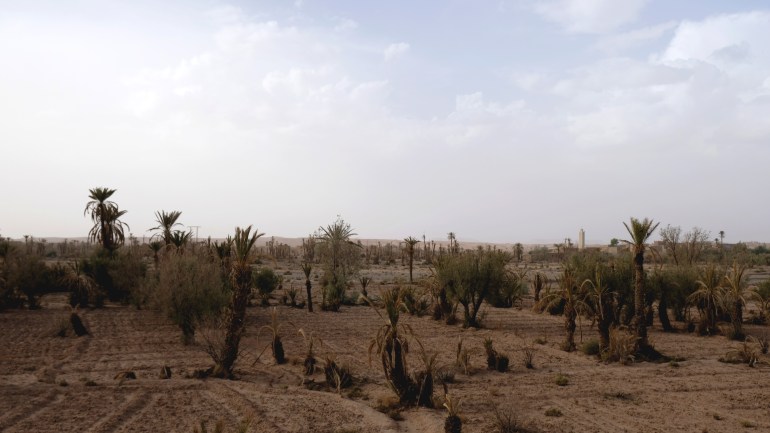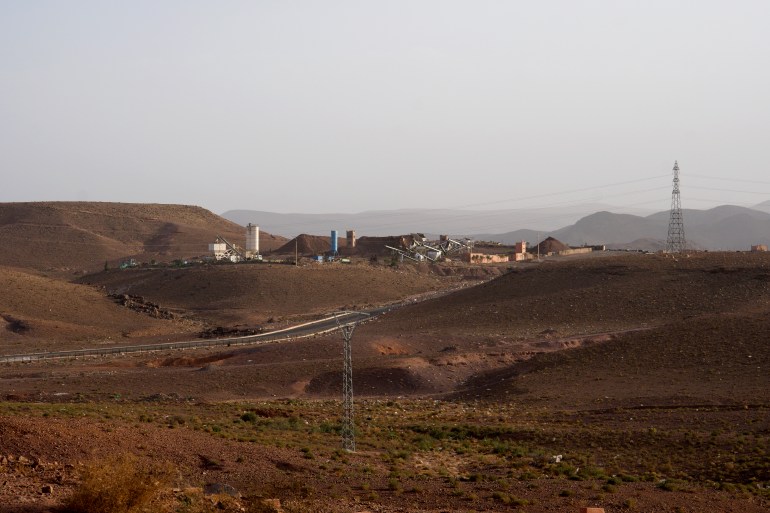As in the rest of North Africa, global warming is already showing its effects and severely affecting agriculture.

By Aïda Delpuech and Arianna Poletti
Published On 11 Nov 202211 Nov 2022
Dades Valley, Morocco – At the foot of the High Atlas mountain chain in southeastern Morocco, each village is named after the river that used to run through it. But today dry palm trees surround empty riverbeds and bridges now cross only stones left underneath.
“When I was a child I used to swim in this river. There was an incredible fish diversity. Today half a century later, my wadi [valley] is completely dry,” says Yousef, a farmer from Kalaat MGouna, east of the gateway city of Ouarzazate.
Yousef, a retired immigrant worker who lived in France, returned to his home village to grow olives, almonds, and pomegranate trees. Little did he know that irrigating his crops would become an impossible task.
The Ouarzazate semi-desert region is drying out. As in the rest of North Africa, global warming is already showing its effects and badly affecting agriculture. In the context of drought, Moroccan farmers point the finger at the mismanagement of remaining water resources, which have been diverted from their natural course to be set aside for expanding industries.
Three industries in southeastern Morocco consume the most water: mining companies, agricultural monocultures, and the world’s largest solar power plant, Noor, generating thermal energy through an evaporation process. Water from the valleys around Ouarzazate is collected in the al-Mansour Eddahbi dam which is below 12 percent of its current capacity.
North Africa’s green transition
“Morocco is a leader in Africa when it comes to the fight against the climate crisis and environmental degradation,” the European Commission’s Executive Vice President for the European Green Deal Frans Timmermans said at the signing of the EU-Morocco Green Partnership a few weeks before the beginning of the COP27 climate summit in Egypt.
Environmental groups in the region have criticised its centralised and extractive resource management of the resource.
“Local communities suffer from the effects of the climate crisis and do not even benefit from these large projects,” says Jamal Saddoq, a representative of Attac Morocco, one of the few associations working on the consequences of the extractive industry in the southeast.
“We live next to gold, silver, lead and cobalt mines, but we ended up believing that our region is just marginalised and poor.”
Along the roads through the desert, it is not uncommon to notice a white smoke cloud – a sign of mining activity. Excluding phosphates, about 40 percent of the mining licenses in Morocco are located in the Drâa-Tafilalet region.
According to a recent interview with the Minister of Energy Transition and Sustainable Development Leila Benali, companies in Morocco produce three million tonnes of minerals per year. Managem group, a Moroccan company operating in the extraction of precious metals and cobalt, owns the main sites in the region.
This is the case of the Imider mine, the largest in Africa, from where precious minerals such as silver leaves for Gulf and European countries.
“We have been protesting since the 1980s, but little has changed except that groundwater is running out. The company is still pumping water, digging wells deeper and deeper,” says one anti-mine activist, speaking on condition of anonymity to avoid repercussions from the authorities.
“That’s why in 2011 we decided to block the pipeline connecting the mine to its water tank.”
As the company’s own website explains, the mining industry needs water to recover precious metals from ore.

Demonstrators have been calling for an equitable distribution of resources, including water. “We got some achievements but not up to what we expected. About 50 young people have been hired and some development projects have been set up,” the activist said.
Managem did not respond to Al Jazeera’s request for an interview. According to the environmental commitments of the company, “we take action to guarantee the future of water resources for our activities, for our neighbouring communities, and for our environment as a whole”.
In June 2022, an agreement between the company and the Renault Group was signed to extract 5,000 tonnes of cobalt sulfate for electric car batteries for seven years starting from 2025. The aim is to “ensure supply chain traceability and reduce environmental impact”.
“How much water will this green project cost?” asks the activist.
Despite the arrest of dozens of anti-mine activists, protests in the region continue as the drought worsens. The most recent water demonstrations in southeastern Morocco were in early October in the Zagora area.
“Protests against mining groups have been joined by protests against the rise of monocultures and the Noor solar power plant. Despite green policies, these economic activities are based on the same extractivist model,” Saddoq of the Attac Association points out.
Intensive agriculture
In operation since 2016, the Noor plant is the world’s largest thermodynamic solar complex. Locals say water is being diverted for the wet cooling phase at the facility.
“Now all the water of our Dades river is directed to the dam, while we need it to penetrate our water table,” says Rochdi, a farmer from Kalaat MGouna. “The remaining water is pumped for intensive agriculture.”
According to the authorities, the average rainfall this season was at its lowest level in more than 40 years.
“Morocco is among the world’s most water-stressed countries,” says a World Bank report. At 600 cubic metres (21,200 cubic feet) of water annually per capita per year, the country is already well below the water scarcity threshold of 1,700 cubic metres (60,000 cubic feet), according to the World Health Organization.
Instead of being equally redistributed among the population, 85 percent of national water consumption is swallowed by intensive agriculture, mostly for market produce such as watermelon and avocado, and arboriculture, including almonds and citrus fruit. These crops are water-intensive and mostly intended for export, at the expense of local subsistence farming.
The choices made by the kingdom in terms of the agricultural policy were set in stone in 2008 through the Green Morocco Plan, a 10-year strategy aimed at making the agricultural sector a priority for the country’s socioeconomic development. Modernisation, intensification, crop diversification, and land liberalisation were the keywords.
Nizar Baraka, Morocco’s minister of water and equipment, has called for reduced “water losses in the transport and distribution networks”, and “containing the demand for irrigation water”.
Baraka also promoted “investing in the modernisation of agriculture as an essential means to ensure and develop water and food security”.
Dribs and drabs
In recent years, the region of Skoura, south Ouarzazate, which is already under stress from mining activities, has become a leading destination for large investments in watermelon production. Since 2008, the surface allocated to watermelon crops has multiplied 10-fold, jeopardising local water resources for small-scale farmers and villagers.
In Zagora, a small town of 30,000 inhabitants, water is distributed in dribs and drabs, a few hours a day.
“People are fleeing our valley to join the city or often seek opportunities abroad,” says Yousef.
“Water access is becoming a matter of public order, as we only survive thanks to our immigrants, who send some money back home,” the farmer adds.
For his part, Yousef aims to propose a counter-agricultural model through his agroecological cooperative farm experimenting with drip irrigation.
“No policy will be effective in preserving oases without a sustainable agriculture based on soil fertility rather than on intensive irrigation,” he says. “Our valley is in great danger. Without water we are at the tipping point of a major collapse”.

SOURCE: AL JAZEERA
https://www.aljazeera.com/news/2022/11/11/preserving-oases-the-fight-for-water-for-morocco-farmers
